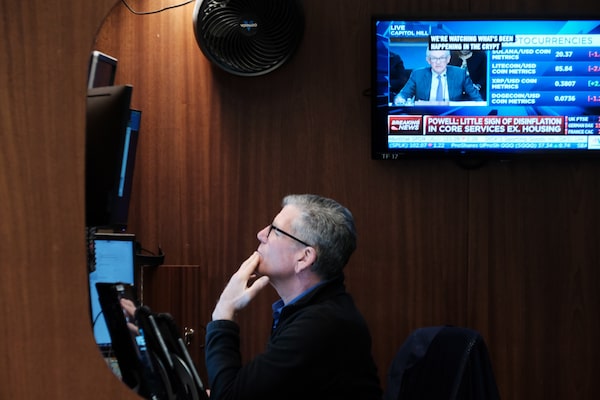
Traders work on the floor of the New York Stock Exchange (NYSE) as Federal Reserve Chair Jerome Powell speaks on Mar. 7 in New York City. Mr. Powell’s comments during a hearing in Washington rattled stocks, bonds and commodities.Spencer Platt/Getty Images
Federal Reserve Chair Jerome Powell on Tuesday warned that larger interest rate hikes may be necessary amid stubbornly high inflation, raising fresh uncertainty about whether the central bank can tame inflation without tipping the U.S. economy into recession.
Mr. Powell’s commentary during a hearing in Washington rattled stocks, bonds and commodities that have been struggling for direction over the past several weeks, as unusually strong economic data underscored concerns that previous rate hikes haven’t slowed activity.
Financial markets now expect there is more than a 65 per cent chance of an aggressive half-percentage point interest rate increase by the Fed later this month, up from about 30 per cent probability of such a move before Mr. Powell’s remarks, according to Reuters.
The S&P 500 Index fell 1.5 per cent. In Canada, the S&P/TSX Composite Index fell 1.2 per cent, while the crude oil price slumped about 3.8 per cent.
Bond yields, which move in the opposite direction to prices, moved higher. That echoed the turbulence of 2022, when the Fed and other central banks raised their key interest rates aggressively in a battle to contain soaring inflation.
“The latest economic data have come in stronger than expected, which suggests that the ultimate level of interest rates is likely to be higher than previously anticipated,” Mr. Powell said in his prepared statement, his last scheduled public remarks before the Fed announces its next rate decision on March 22.
U.S. hiring remains strong, with employers adding 517,000 positions in January, while the unemployment rate is at its lowest level since 1969. Adding to concerns, the Fed’s preferred measure of inflation, the core personal consumption expenditures price index, rose by 4.7 per cent in January, year-over-year, up from 4.6 per cent in December.
“If the totality of the data were to indicate that faster tightening is warranted, we would be prepared to increase the pace of rate hikes,” Mr. Powell added.
Last month, the Fed raised its key rate by a quarter of a percentage point, to a range from 4.5 per cent to 4.75 per cent.
This marked a less aggressive move – the Fed raised its rate by half a percentage point in December and three-quarters of a percentage point in November – which some investors interpreted as a signal that the rate-hiking campaign was nearly over.
Financial markets implied that the key rate would peak at 4.9 per cent, with cuts following as inflation slowed toward the Fed’s 2-per-cent target. Now, financial markets are reflecting a different scenario.
“It’s higher for longer, and maybe faster, for rates. Whether the economy’s resilience can withstand more rate hikes will be seriously put to the test,” Sal Guatieri, senior economist at BMO Nesbitt Burns, said in a note.
He added: “It’s a tough, no-win situation, and one that usually doesn’t end well for the economy.”
Mr. Powell’s comments put Canadian central bankers in an awkward position. In January, Bank of Canada Governor Tiff Macklem announced a “conditional pause” on further rate hikes, and the central bank is widely expected to hold its benchmark rate steady at 4.5 per cent at its rate decision on Wednesday.
Some economists argue that the Bank of Canada is right to press pause earlier than the Fed. Inflation is lower in Canada than in the United States. Likewise, higher levels of household debt and shorter mortgage terms make the Canadian economy more sensitive to rising borrowing costs.
Still, if the Fed keeps hiking while the Bank of Canada stands pat, that could put downward pressure on the Canadian dollar, increasing the cost of imports and adding to inflation in Canada.
Financial markets have been sensitive to shifting perceptions of Fed monetary policy.
The S&P 500 rallied about 10 per cent from early January to early February on expectations that the Fed might pull off a so-called soft landing, in which rate hikes cool inflation without causing a recession, leaving corporate profits relatively unscathed.
But the rebound in stocks has faded in recent weeks, as economic data suggested that the central bank’s work is not done. The S&P 500 has fallen nearly 5 per cent from its 2023 high. The S&P/TSX Composite has fared better, though it is down about 2.3 per cent over the past three weeks.
Similarly, bond yields began moving higher again in early February, reversing encouraging declines in December and January as signs of moderating U.S. inflation and economic activity emerged.
Following Mr. Powell’s remarks on Tuesday, the yield on the two-year U.S. Treasury note jumped above 5 per cent, hitting a new multiyear high.
With a file from Mark Rendell
 David Berman
David Berman